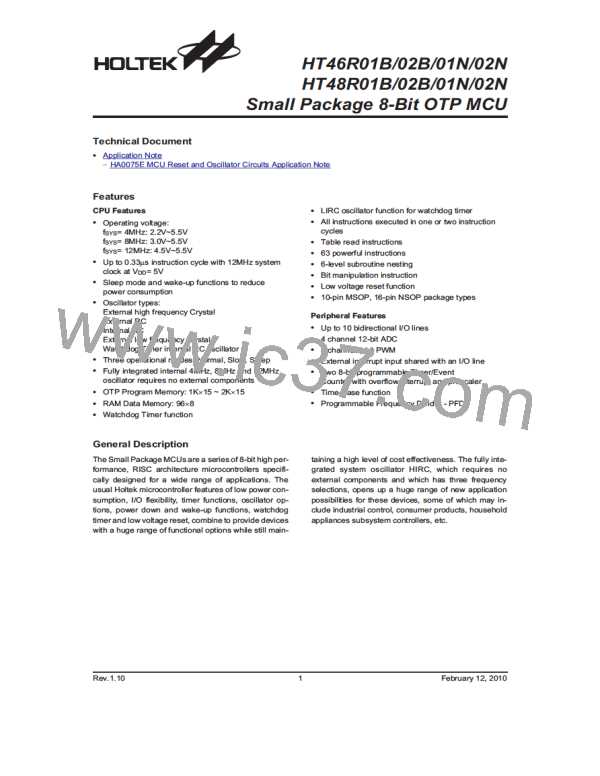HT46R01B/02B/01N/02N
HT48R01B/02B/01N/02N
¨
HT48R01B/HT48R02B/HT48R01N/HT48R02N
Bit
Name
R/W
7
6
5
4
3
2
1
0
TBF
R/W
0
TBE
R/W
0
¾
¾
¾
¾
¾
¾
¾
¾
¾
¾
¾
¾
¾
¾
¾
¾
¾
¾
POR
Bit 7~6
Bit 5
unimplemented, read as ²0²
TBF: Time Base event interrupt request flag
0: inactive
1: active
Bit 4~2
Bit 1
unimplemented, read as ²0²
TBE: Time base event interrupt enable
0: disable
1: enable
Bit 0
unimplemented, read as ²0²
Timer/Event Counter Interrupt
Programming Considerations
For a Timer/Event Counter interrupt to occur, the global
interrupt enable bit, EMI, and the corresponding timer
interrupt enable bit, TnE, must first be set. An actual
Timer/Event Counter interrupt will take place when the
Timer/Event Counter request flag, TnF, is set, a situation
that will occur when the relevant Timer/Event Counter
overflows. When the interrupt is enabled, the stack is
not full and a Timer/Event Counter n overflow occurs, a
subroutine call to the relevant timer interrupt vector, will
take place. When the interrupt is serviced, the timer in-
terrupt request flag, TnF, will be automatically reset and
the EMI bit will be automatically cleared to disable other
interrupts.
By disabling the interrupt enable bits, a requested inter-
rupt can be prevented from being serviced, however,
once an interrupt request flag is set, it will remain in this
condition in the interrupt register until the corresponding
interrupt is serviced or until the request flag is cleared by
a software instruction.
It is recommended that programs do not use the ²CALL
subroutine² instruction within the interrupt subroutine.
Interrupts often occur in an unpredictable manner or
need to be serviced immediately in some applications. If
only one stack is left and the interrupt is not well con-
trolled, the original control sequence will be damaged
once a ²CALL subroutine² is executed in the interrupt
subroutine.
Time Base Interrupt
All of these interrupts have the capability of waking up
the processor when in the Sleep Mode.
For a time base interrupt to occur the global interrupt en-
able bit EMI and the corresponding interrupt enable bit
TBE, must first be set. An actual Time Base interrupt will
take place when the time base request flag TBF is set, a
situation that will occur when the Time Base overflows.
When the interrupt is enabled, the stack is not full and a
time base overflow occurs a subroutine call to time base
vector will take place. When the interrupt is serviced, the
time base interrupt flag. TBF will be automatically reset
and the EMI bit will be automatically cleared to disable
other interrupts.
Only the Program Counter is pushed onto the stack. If
the contents of the register or status register are altered
by the interrupt service program, which may corrupt the
desired control sequence, then the contents should be
saved in advance.
Rev.1.10
52
February 12, 2010

 HOLTEK [ HOLTEK SEMICONDUCTOR INC ]
HOLTEK [ HOLTEK SEMICONDUCTOR INC ]